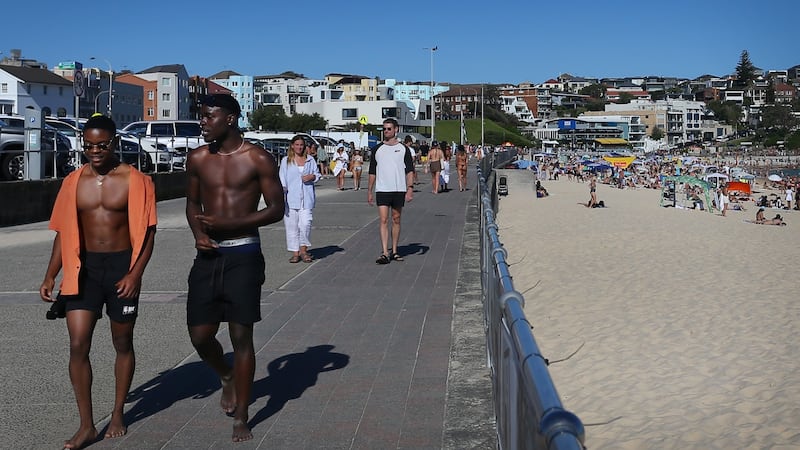The return of foreign visitors to Australia after a two-year absence cannot come soon enough for Craig Wachholz, who runs a surf school on Sydney's Bondi beach.
“You don’t know what you’ve got until it’s gone,” said Wachholz, known as Wacca to fellow surfers. Overseas tourists were a large proportion of the 10,000 to 20,000 people that took lessons with his company each year but that flow dried up as the borders shut.
“We’ve been on Bondi beach for 27 years and up until Covid hit we were having the best year we’d ever had. But then the beaches were shut and we fell off a cliff,” he said.

The strict border lockdown under the “Fortress Australia” policy had a catastrophic impact on the tourism industry of a country that welcomed nine million visitors a year before the pandemic.
Shane Jolly, general manager of the five-star Langham Hotel in Sydney's historic Rocks district, spoke of the "devastating" visitor ban. "There's been a very heavy toll," he said.
On Bondi, businesses have had to make do, gradually picking up customers as Covid-19 restrictions eased. First, locals looking for safer outdoor activities returned to the surf, followed by domestic tourists and backpackers who entered on work visas and headed straight to Sydney’s most famous sands.
Wachholz said that within days of a travel bubble to Singapore opening last year, he had wannabe surfers from the city-state on the beach looking for lessons. "We are right at the front of it," he said of the recovery.
Flight bookings
The big wave of visitors strikes next week with the full return of tourism. When Scott Morrison, prime minister and a former Tourism Australia chief, announced last month that double-vaccinated overseas visitors would be welcomed back for the first time since early 2020, the effect was instantaneous.
Flight bookings to Australia doubled the following day, with the strongest demand from the US and UK, but also South Africa, Canada and India, said Andrew David, chief executive of domestic and international operations for airline Qantas. "This shows how much people want to come to Australia," he said.
The Cruise Bar overlooking Sydney’s Opera House is one of those poised to cater for the new arrivals. Lindsay Potts, its marketing manager, said: “Like any hospitality business during this time we’ve struggled so we’re super excited to welcome back international tourists. It’s a huge market for us.”
The end of a ban on dancing and singing in public in Sydney also meant the venue could resume putting on shows for its guests. "We're definitely going to throw some sort of party," she said.
Tourism chiefs have jumped on the reopening. A new A$40 million (€25 million) advertising campaign with the "Don't Go Small, Go Australia" tagline has launched across Europe and the US, with a sun-drenched kangaroo appearing on a billboard overlooking London's Piccadilly Circus in recent days.
International visitors were worth A$61 billion to the Australian economy before coronavirus struck, according to Tourism Australia, and the industry employs more than twice the number of people than the important mining industry.
And while Sydney is the hub of the tourist industry, businesses in more remote areas of Australia are also counting on a recovery.
Matt Cameron-Smith, chief executive of Voyages Indigenous Tourism Australia, which relies on foreign visitors to Uluru in the Northern Territory for half its revenues, said the reopening felt like a long time coming after so many false starts.
“You go from watching the news with one eye closed to saying ‘is this real?’,” he said of next week’s reopening.
Lost workers
Yet the industry still faces a huge battle to return to its pre-Covid pomp. The workforce withered during the pandemic, with some leaving for steadier work in retail and healthcare, and about 100,000 workers returned to their home countries.
The government has sought to address the issue by refunding the cost of working visas to visiting backpackers but John Hart, executive director of Restaurant and Catering Australia, doubted this would be sufficient.
“We’re not going to get them back,” he said of the lost workers, adding that a shortage of skilled staff such as chefs was a real concern.
Another looming problem is political tension with China, which provided the largest number of annual international tourists, 1.4 million, before relations became strained.
"Some Chinese will return but nowhere near the numbers we had. We need to target well-heeled markets," said Hart, who wants to attract high-spending tourists from countries such as Japan and India to fill the gap.
Langham Hotel’s Jolly said there had been a pick-up in international bookings since the border announcement, but he expected it to take until next summer for wealthy customers to return in high numbers because of fears that the borders could shut again.
“Planes are not lining up to drop in five-star luxury guests,” he said. “Business people will travel if they have to but luxury leisure travellers can’t afford to get stuck.”
Hart rued the furore last month over the deportation of the tennis star Novak Djokovic, which he said painted Australia's border security policies in a harsh light.
“It wasn’t a good look,” he said, arguing that they needed to make the visitor experience as easy as possible now to restore its image.
For Wachholz, the pause in mass tourism did provide one benefit: a reminder of the “vibe” that Bondi had when he first began surfing there decades ago, something he hoped would remain after the crowds returned.
“Maybe people will enjoy the beauty of Bondi beach a bit more now,” he said. – Copyright The Financial Times Limited 2022










